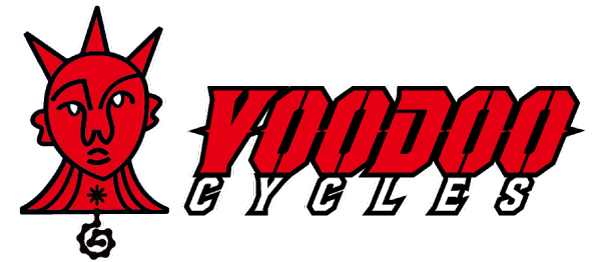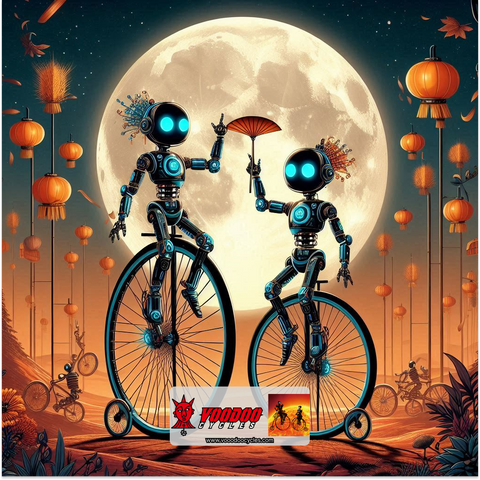
Discover all the parts of a bike. Learn about the bicycle frame materials, fork, handlebars, saddle ergonomics, pedal systems, derailleurs, shifters, drivetrain components, brake mechanisms, wheels, and tire specifications. Understand their functions, types, and how they contribute to a smooth and enjoyable ride. This comprehensive guide will explain each bike part, providing valuable insights for cyclists of all levels.
Frame

The bike frame is the backbone of any bicycle; it provides the structure that holds all the other components together. Different types of bike frame geometry are designed for distinct uses, separated into three categories: mountain biking, road racing, and gravel and cyclocross.
Mountain Bike Frames
Designed for off-road conditions, these frames usually feature suspension systems (front, hardtail, or full). Mountain bike frame geometry typically includes a slacker head tube angle and longer reach to assist with stability during descents and technical handling.
Road Racing Frames
Lightweight frames are designed and optimized for speed and aerodynamics on paved surfaces. These bikes have more aggressive geometry with a steeper head tube angle that promotes a lower and more aerodynamic riding position.
Gravel Bike and Cyclocross Frames
Gravel bike designs blend features of both mountain bikes and road bikes, making them more adaptable for mixed terrains. They often feature a longer wheelbase and slacker angles compared to road bikes to offer more stability and comfort for long rides on mixed terrains.
Bike frames can also consist of different materials such as steel, aluminum, titanium, and carbon fiber frames. Steel frames are robust but heavy. Aluminum alloy offers an excellent strength-to-weight ratio at an affordable price. Titanium frames are lightweight, durable, and corrosion-resistant. Carbon fiber frames are the lightest option, offering superior stiffness ideal for competitive cycling.
Fork

The fork is the part of the bike that holds the front wheel in place, allowing steering and stability. IIt consists of two blades joined at the top by a fork crown with a steerer tube extending above the crown to connect it to the frame and handlebars via a stem. The bottom of the fork features fork ends holding the wheel either through bolted axles or quick-release skewers. Various fork designs, including rigid and suspension forks, can have a significant influence on the bike’s handling and ride quality.
Rigid Forks
They do not have any suspension and are generally lighter than suspension forks, making them preferable for riders focused on efficiency and speed. Typically more affordable due to having fewer moving parts, this also results in less maintenance and a lowered possibility of mechanical failure, making them an attractive option for budget-conscious cyclists and commuters who may encounter harsher weather conditions.
Suspension Forks
Designed to absorb bumps and shocks to provide a smoother riding experience on rough or uneven terrain, significantly enhancing comfort on mountain trails and longer rides. Many suspension forks today come with features like the lockout setting, creating versatility by allowing riders to adjust the level of suspension catered to the demand of terrains. On technical trails or during descents, suspension forks increase control and stability, fitted to more aggressive tails and riding styles.
Handlebars

Handlebars significantly influence the riders’ comfort, control, and performance as they are the main steering mechanism for the bike. They come in various types such as drop bars, flat bars, riser bars, bullhorn bars, and aero bars. Each design caters to specific cycling styles:
Drop Bars
With a distinctive shape commonly used on track and road bikes, it has a straight central section and ends that curve downwards. These handlebars allow multiple hand positions and promote aerodynamics and comfort during longer rides.
Flat Bars
Characterized by a nearly straight tube that may have a slight bend towards the rider, they are typically found on hybrid, commuter, and mountain bikes. Flat bars are easy to control, providing the rider with a more upright riding position, which enhances riders’ visibility.
Riser Bars
Similar to flat bars with a slight rise in the center clamp area. Popular on mountain and hybrid bikes, they offer a more comfortable grip and better control, especially on rougher off-road conditions.
Bullhorn Bars
Resembling a bull’s horn, it extends forward and curves upwards. They provide a forward-leaning position for the rider, enhancing control and aerodynamics. These properties make them suitable for sprinting and aggressive riding styles, resulting in common sightings in track tracking and single-speed bikes.
Aero Bars
Designed for maximum aerodynamics, aero bars feature a parallel bar setup that allows the rider to lean forward. They minimise wind resistance to allow the rider to achieve higher speeds, making them ideal for competitive cycling events like triathlons.
Saddle

The saddle, or seat, is where you sit. Saddles vary in shape and padding, and choosing the right one is key for comfort during long rides. Choosing the right saddle is highly personal and depends on various factors, including body morphology, riding style, posture, and paddling preferences all influences saddle choice. Proper saddle ergonomics are crucial for comfort during long rides. A saddle that is too narrow can cause excessive pressure on the sit bones. One that is too wide provides inadequate support in the center channe can lead to discomfort and chafing. Comfort can vary significantly from one rider to another, so personally testing different saddles to find the right fit is recommended.
Pedals
Pedals are where the rider places their feet to propel the bike forward; they serve as the primary interface between the rider and the bicycle. Just like handlebars, they come in various designs, each suited for a distinct cycling style and preferences.
Clipless Pedals
Unlike traditional pedals, clipless pedals require the rider to attach clears to their shoes, creating a secure connection. It optimizes pedalling efficiency by minimizing foot movement, leading to improved power transfer and control. Single-sided clipless pedals are usually used for road bikes, and double-sided pedals are often more favored in mountain biking. Although they provide a firm connection, new users may experience a steep learning curve as they adjust to the unclipping process, which can potentially lead to falls.
Flat Pedals
Flat pedals are characterized by their wide platforms, they allow the riders to place their feet anywhere, providing a greater freedom of movement. This makes them a suitable option for beginners and casual cyclists. In mountain biking, flat pedals enable quick foot placement and removal, enhancing balance and technique. Additionally, the ability to easily put a foot down provides an added layer of safety.
Combi Pedals
Also known as hybrid pedals, combi pedals offer the best of both words by combining the features of clipless pedals and flat pedals. Depending on individual riders’ needs, this hybrid design gives riders the choice between a flat surface or a mechanism for clipless cleats. Combi pedals are particularly valuable for riders who may need to switch between regular shoes and cycling shoes for different situations.
Cage Pedals
Cage pedals (sometimes called toe clips) is a traditional style of pedal featuring a cage that holds the rider’s foot in place using straps. While they provide some benefits of foot retention, they are generally less efficient and more cumbersome. Riders can still easily remove their feet, but the setup is not as streamlined as the clipless system. Cage pedals have become less common in modern cycling, with clipless pedals offering superior ease of use and performance.
Your choice of bicycle pedals should be based on your cycling goals, preferences, and your riding style. Each pedal type offers unique advantages and disadvantages, so it’s important to carefully consider how they align with your cycling habits.
Derailleurs & Shifters

Derailleurs and shifters are a key part of modern bicycles that shift the chain between sprockets. It enables riders to shift gears seamlessly while riding, enhancing performance efficiency. Since its invention by Paul De Vivie in 1905, it has revolutionized the cycling industry. Its debut in the 1937 Tour de France surged its popularity and marked a major turning point in the sport.
Today, road bikes usually use drop handlebars, with the left shifter usually controlling the front derailleur and the right controlling the rear. For mountain bikes and hybrid bikes, shifting is usually done by using thumb paddles or grip shifts.
When shifting the front derailleurs, the larger chainring makes pedaling harder, making it optimal for descents and reaching higher speeds. On the contrary, shifting to the smaller chainring makes pedaling easier, making it ideal for steep climbs. Mirror this mechanic: on the back derailleur, the larger cog makes pedaling easier, and the smaller cog makes pedaling easier.
In recent decades, this technology has further evolved with the introduction of electronic shifting systems. The classic mechanical shifting system consists of gear levers and mechanical cables. Electronic shifting systems today use electronic switches with a battery pack without cables. Electronic shifting systems allow swift shifting at the push of a button. On top of that, many today also include automatic adjustment for the front derailleur, further simplifying the process.
Drivetrain Parts

The drivetrain includes the belt drives, bottom bracket, cassette, chain, chainrings, crankset, derailleurs, hub gears, and shifters. These parts transfer your pedaling power to the rear wheel, propelling the bike efficiently and making your ride easier. The main types of drivetrains found today are derailleur gears, single-speed and fixed-gear, internal geared hubs, and E-bike drivetrains.
Derailleur Gears
The most common type found on modern bicycles, especially on road and mountain bikes. They utilize a system of derailleurs that shifts the chain between multiple gears on the front chainrings and rear cassette. There are several types of derailleur gears—1x, 2x, or 3x drivetrain. The 1x drivetrain simplifies shifting; it features a single front chainring with a wide-range rear cassette, eliminating the front derailleur; it is popular amongst mountain and gravel bikes. Incorporating two or three front chainrings along with a rear derailleur, the 2x or 3x drivetrains allow for a broader range of gears and can often be found on road bikes.
Single-Speed and Fixed-Gears
Single-speed drivetrains only have one gear ratio, meaning they do not have derailleurs or multiple gears. Fixed-gear bikes, also known as fixies, are a subset of single-speed bikes where the rear wheel and the pedals are directly connected, meaning that pedalling forward moves the bike forward and backward slows the bike down. The advantages of these drivetrain types are their simplicity and efficiency of direct power transfer without energy loss. Fewer components also mean less maintenance and lighter weight.
Internally Geared Hubs
Internally geared hub designs can be commonly found in commuter bikes. They house the gearing mechanism within the hub of the rear wheel. It allows for gear changes without external derailleurs. The design allows riders to change gears while stationary with no risk of the chain falling off. It is also low maintenance, as it’s protected from elements, leading to less wear and tear.
E-bike Drivetrains
Usually more robust handling additional power from electric motors. It can use traditional derailleur systems or have a unique configuration depending on the motor type.
Brakes

Brakes are critical for controlling your speed in slowing down or stopping safely. There are several brake types with distinct mechanisms and applications; three of the main ones are rim brakes, disc brakes, and drum brakes.
Rim Brakes
Rim brakes operate by the application of friction to the wheel’s rim. They are typically actuated by levers mounted on the handlebars, coming in three variations: caliper brakes, v-brakes, and cantilever brakes. Caliper brakes are commonly adopted by road bikes consisting of a single unit that pivots at a single point. V-brakes are more popular on mountain bikes, offering better performance from their long arms providing greater leverage. Cantilever brakes, although less prevalent now in general, are usually only found on some touring bikes; they were once common on cyclocross bikes.
Disc Brakes
Disc brakes use a caliper to squeeze brake pads against a rotor attached to the wheel hub, providing consistent stopping power even in rough weather conditions. They come in two types: mechanical disc brakes and hydraulic disc brakes. Mechanical ones are operated by a cable; it is generally cheaper due to the less break power it provides. Hydraulic ones are more complex, offering superior stopping power and modulation and, as a result, being more expensive.
Drum Brakes
Drum brakes are enclosed systems that use the friction from brake shoes against a drum to slow the wheel. Almost extinct now, they are found on older models or specific types of bikes.
Wheels & Tires

A bicycle wheel consists of rims, spokes, and hubs, with the tires coming in different types. The rims are the circular parts of the wheel that hold the tires; they can come in various materials, like the bike’s frame, and different widths, which impact the weight and aerodynamics. Spokes are crucial for the wheel’s strength and stiffness; they are the component that connects the rim to the hub. The number and arrangement of the spokes can determine the wheel’s performance and durability. Hubs are located at the center of the wheel, housing the axle and allowing the wheel to rotate; its design can be catered to various types of brakes and gear systems.
Bicycle wheels usually come in three types: road wheels, mountain bike wheels, and hybrid wheels. Road wheels are generally lightweight and designed for aerodynamics, assisting higher speeds on paved surfaces. Mountain bike wheels are often wider and more robust for the purpose of handling rough terrain and obstacles. Hybrid wheels are a combination of the two, making them suitable for a variety of surfaces.
Bike tires also come in different types, usually classified into two categories: solid tires and pneumatic tires. Solid tires are made from rubber or foam. Often used in specific cases like children’s bikes, these tires do not puncture with the trade-off of offering less cushioning compared to pneumatic options. Pneumatic tires are filled with air to provide cushioning and reduce rolling resistance; they are the most common type of tires. They can be categorized into three types: clincher tires, tubular tires, and tubeless tires.
Clincher tires
Clincher tires consist of two parts: the tire itself and the inner tube that holds the air. They have a bead that clinches to the rim, keeping it in place securely. They’re the most common type of tire found on bikes. It’s easy to repair, cost-effective, and available with a variety of uses catering to different types of cycling. If the clincher tire goes flat, only the inner tube needs to be repaired.
Tubular Tires
Single-piece tires have the inner tube sewn into the tire itself; it’s glued into the rim, which makes them less common but favored by some serious cyclists, especially competitive ones. They are often lighter compared to clincher tires, providing better ride quality due to their construction allowing lower pressure and improved grip. They tend to be more durable and resistant to pinch flats. The downside is that it’s generally more costly and more difficult to install and repair. If it goes flat, the entire tire will have to be replaced.
Tubeless Tires
A newer technology, tubeless tires eliminate the inner tube. They rely on sealant to maintain air pressure and create a seal between the tire and the rim. The sealant used can seal small punctures automatically, as a result, increasing its puncture resistance and reducing the likelihood of flats. Like tubular tires, they are more complicated than clinchers, making maintenance more taxing. Its sealant needs to be replenished periodically, and if a larger puncture occurs, repairs are comparably more challenging.
Conclusion
Now that you have a deeper understanding of bicycle parts—ranging from frame materials to braking mechanisms—you can make informed decisions about upgrades or maintenance. Whether you're into mountain biking, road cycling, or gravel riding, this knowledge will enhances your experience on every ride. So, saddle up and hit the road! Let's Cycle to Mars together.






